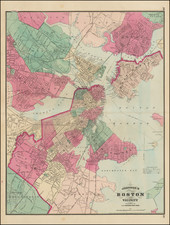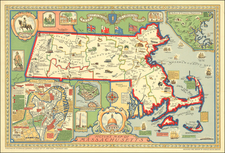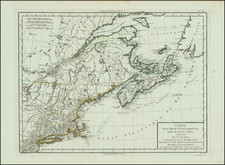Sevemteenth Century Plat Map of Mount Wollaston Farm in Braintree, Mass., Later Owned by Two Presidents
Original 1669 plat map for Mount Wollaston Farm in Braintree, Massachusetts (now Quincy) later owned by Presidents John and John Quincy Adams and one of the most historically-rich and resonant pieces of the American landscape.
Background
The area of Quincy (then Wollaston), on the shore of Quincy Bay some seven miles south of Boston, was first occupied by Europeans in 1625, when it was settled by Captain Richard Wollaston, Thomas Morton and a small grouip of servants. Naming the location Mount Wollaston, the two leaders soon parted and Wollaston fled, leaving Morton to establish Merrymount, a quasi-utopian, free-living community that was soon dismantled by the outraged Puritans of nearby Plymouth. In the 1630s, the Town of Boston granted Anne Hutchinson and her husband some 600 acres of land in the area, though no doubt came to regret it when her unorthodox religious views provoked the so-called “Antinomian Controversy”. In 1640, the area was incorporated as the Town of Braintree, much of which was split off in 1792 to create Quincy.
The parcel shown on this map (totalling about 400 acres), was granted in 1635 to William Coddington and Edmund Quincy. Quincy died the following year, while Coddington, who joined the Hutchinsons in the Antinomian Controversy, soon departed to join them in Exeter, New Hampshire. The parcel was then acquired by Boston merchant William Tyng, probably in 1638 or -39, and in 1661 it passed by inheritance to Tyng’s daughter Anna. Anna Tyng married Reverend Thomas Shepard II (1635-77), and by the law of the land the parcel fell under Shepard’s control until his death, after which it reverted to Anna (hence the handwritten annotation “this plott belonging to Mr. Thomas Shepard” rather than Anna)
The Manuscript Plat Map
The map and text describe the parcel as bounded by “the salt water” (i.e., Wollaston Bay, now Quincy Bay) to the north, “Quinseys Creek” (now Blacks Creek) to the west, and several different landowners to the south and east. On a modern map, this area shows as the base of an irregular peninsula jutting into Quincy Bay, with Town River Bay and Rock Island Cove to the south. The parcel is broken up by three smaller parcels, marked by dotted lines, with owners identified in the text block at right. Four crudely-rendered trees along the boundary line indicate trees that have been blazed with Shepard’s “S”; how the various owners marked their property lines is otherwise left to the imagination. Off shore from the plat, “Half Moone Island” is shown, which today is no longer visible above water. The plat is dated “1. Desember 1669” and signed only “J.F.F.”, whose identity is not known to us.
Though the rendering appears crude, the map is almost certainly far more than a mere sketch made “by eye”. Rather it appears to be the product of a “metes and bounds” survey, in which a compass and measuring chain or rod were used to run a continuous boundary by breaking it up into smaller straight-line segments. That this is so is indicated by the relatively precise scale bar at lower left, giving a scale of approximately X rods to the Y. Further evidence is provided by the numerous tiny dots along the parcel boundary, demarcating the individual segments measured by the surveyor. He would have recorded the bearing and distance of each segment in his field notes (not present here), then later worked from those notes to plot the map.
Owned by Two Presidents
In 1682, some years after this map was drawn, Thomas and Anna Shepard’s daughter Anna married Daniel Quincy, the eldest son of the aforementioned Edmund Quincy. They had a son, John Quincy, to whom Anna Shepard bequeathed the parcel at her death in 1709. John Quincy served for thirty years as Speaker of the Massachusetts House. In 1792, the Town of Quincy was named after John Quincy. John Quincy was also the grandfather of Abigail Adams, and in 1801 Abigail and her husband, former President John Adams, inherited the property. On John Adams death in 1826, it passed by inheritance to their son John Quincy Adams, then serving as President.
Transcription of the text
Left
“The land represented by this plott belonging to Mr. Thomas Shepard (lying [in ye?] Town of Brantrey conteynes [words effaced] hundred acres (those parcels being [words effaced] belonging to other men) and is [bounded?] from A to B by Mr. Edmond Quinsey and the townes land from B to C by marshe belonging to several persons from C to D by marshe belonging to Gregorie Belcher, from D to E by the towne land, from E to F by marshe belonging to Peter George, from F to G by land commonly called [???], and from G to A by the salt water.
“The trees that are marked in the lines are generaly marked with S upon that side which is … to Mr. Shepards land [last few words illegible].”
Right
“That parcel marked GB and M conteyneth 12 acres and belongeth to Gregory Belcher and [Sirgant?] Matson and is devided from Mr Shepards at the prikt line [???] by upland and upon the other side by a woode; that parcel marked with B conteyneth 8 acres upland and marshe
and belonging toand belongeth to Samuell Belcher and bounded by a creeke [exept] at [illegible] a line of stakes; the other parcel marked N. H. B conteyneth 8 acres, belongeth to William [???] Holbrooke and Peter [???], and is divided from Mr. Shepards upland at a little spot at H which is staked out
Rarity
Manuscript maps and plans from the first century of settlement in England’s American colonies are of the greatest rarity. To encounter one with so many significant and illustrious connections is extraordinary.
Provenance: Lineal descendant of the Prescott family, who are related to the Adams family etc. .Purchased at Doyle, March 2022.














![(Colonial New England Ironworks) [Early 19th-century manuscript copy of 1674 New England land transaction involving John Gifford; mention of early ironworks in Massachusetts]](https://storage.googleapis.com/raremaps/img/small/93113.jpg)

![[Plymouth Bay, Cape Cod Bay, Duxbury Bay]](https://storage.googleapis.com/raremaps/img/small/51249.jpg)